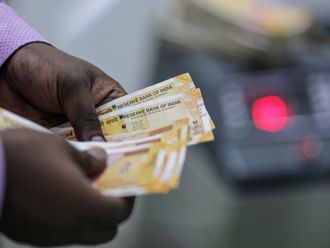US dollar
The US dollar index - a measure of its performance against a basket of six currencies, fell to 80.122, it’s lowest since early August after the US Federal Reserve announcements. The Fed on Wednesday expressed greater concern about sluggish US growth and low levels of inflation in a statement that many took as opening the door wider to pumping new dollars into the economy. The Fed said "The committee is prepared to provide additional accommodation if needed to support the economic recovery and to return inflation, over time, to levels consistent with its mandate," it said in the statement. While further steps by the Fed are seen as dependent on data, its statement highlights the wide gap between the US and the likes of Australia which is tightening policy. Compounding the dollar's problems was a fall in Treasury yields, with short-dated yields at record lows after the Fed's statement, narrowing yield spreads and making US debt less attractive to Japanese investors.
Euro
The euro surged to a 6-week high against the dollar and broke above its 200-day moving average for the first time since January, suggesting more gains were ahead. After the announcement the euro was up 1.6 percent at $1.3260 after climbing as high as 1.3281, it’s highest since Aug. 9. Charts wise as long as the euro holds above the $1.3030 area, further gains some to Aug. 6 high of $1.3334 is a close possibility. The euro also breached technical resistance at its 200-day simple moving average. Long-term moving averages are stronger resistance levels in this instance. Once breached, the new level would become long-term support for the currency. The 14-day simple moving average crossed the 50-day simple moving average, which is also bullish for the euro in the near term.
Yen
Japanese yen fell on Wednesday to its weakest level against the US$ since Japan intervened last week, fuelling speculation of more intervention after the Federal Reserve raised expectations it would print more dollars to help the US economy. The dollar hit it’s lowest in seven weeks against the euro and a basket of currencies, and dropped below 85.00 yen which spurred speculation Japanese authorities may intervene to curb yen gains after they resumed intervention for the first time since 2004 last week. The market had shied off selling the dollar aggressively down to 85.00 yen, fearing it might be an intervention trigger, but authorities were so far not seen in the market on Wednesday.
Indian rupee
The Indian rupee strengthened to fresh four-month highs on Wednesday tracking broad dollar losses after the Federal Reserve signalled more easing, with gains in local shares and hopes for more capital inflows, also aiding. Indian shares ran out of steam after climbing to 32-month highs for the eighth successive session on Wednesday, strengthening the case for consolidation following an 11 percent rally over three weeks. The rally has been boosted by foreign fund inflows of $3.3 billion this month. Net foreign investment in stocks have risen to more than $16 billion so far in 2010, on course to probably exceed last year's record $17.5 billion inflow. The buying has lifted the BSE index 14.3 percent in the year to date, making the benchmark the best performer among its peers in Brazil, Russia and China.
Gold
Gold climbed to a record for a fifth straight day as the dollar slumped after the Federal Reserve said it was willing to ease monetary policy further to boost the US economy. Gold hit a fresh all time high of $1,291.05 in the early trades of Wednesday. Gold, which often moves counter to the dollar, has advanced 17 percent this year and is heading for its 10th annual gain.
Source: Richcomm Global,












